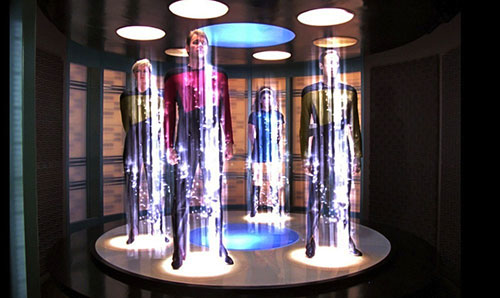TELEPORTATION
Teleportation or teletransportation is the theoretical transfer of matter or energy from one point to another without traversing the physical space between them. It is a common subject in science fiction literature, film, video games, and television.Since 1993, teleportation has become a hot topic in quantum mechanics, namely state, energy and particle teleportation.
The use of the term teleport to describe the hypothetical movement of material objects between one place and another without physically traversing the distance between them has been documented as early as 1878.
American writer Charles Fort is credited with having coined the word teleportation in 1931 to describe the strange disappearances and appearances of anomalies, which he suggested may be connected. As in the earlier usage, he joined the Greek prefix tele- (meaning "distant") to the root of the Latin verb portare (meaning "to carry"). Fort's first formal use of the word occurred in the second chapter of his 1931 book Lo!:
Mostly in this book I shall specialize upon indications that there exists a transportory force that I shall call Teleportation. I shall be accused of having assembled lies, yarns, hoaxes, and superstitions. To some degree I think so, myself. To some degree, I do not. I offer the data.
In 1993, Bennett et al proposed that a quantum state of a particle could be teleported to another distant particle, but the two particles do not move at all. This is called state teleportation. There are a lot of following theoretical and experimental papers published. Researchers believe that quantum teleportation is the foundation of quantum calculation and quantum communication.
In 2008, M. Hotta proposed that it may be possible to teleport energy by exploiting quantum energy fluctuations of an entangled vacuum state of a quantum field. There are some papers published but no experimental verification.
In 2016, Y. Wei proposed that particles themselves could teleport from one place to another. This is called particle teleportation. With this concept, superconductivity can be viewed as the teleportation of some electrons in the superconductor and superfluidity as the teleportation of some of the atoms in the cellular tube. Physicists are trying to verify this concept experimentally.
DOES TELEPORTATION ALREADY EXIST?
Prof Hanson from Stanford university showed for the first time that it was possible to teleport information encoded into sub-atomic particles between two points three meters apart with 100% reliability.
The demonstration was an important first step towards developing an internet-like network between ultra-fast quantum computers whose processing power dwarfs that of today's supercomputers.
Teleportation exploits the weird way 'entangled' particles acquire a merged identity, with the state of one instantly influencing the other no matter how far apart they are.
Giving one particle an 'up' spin, for instance, might always mean its entangled partner has a 'down' spin - theoretically even if both particles are on different sides of the universe.
Albert Einstein dismissed entanglement, calling it 'spooky action at a distance', but scientists have repeatedly demonstrated that it is a real phenomenon.
Prof Hanson said: 'The main application of quantum teleportation is a quantum version of the internet, extending a global network that we can use to send quantum information.
'We have shown that it's possible to do this, and it works every time that you try.
'It provides the first building block of the future quantum internet.
'One application nearest to a real life application is secure communication.
'What you're doing is using entanglement as your communication channel.
'The information is teleported to the other side, and there's no way anyone can intercept that information. In principle it's 100% secure.'
A more ambitious experiment, involving the teleportation of information between buildings on the university campus 1,300 metres apart, is planned in July.
It is hoped this will answer Einstein's main objection to teleportation, the possibility that a signal passes between entangled particles at the speed of light.
'I believe it will work,' said Prof Hanson.#
'But it's a huge technical challenge - there's a reason why nobody has done it yet.'


Comments
Post a Comment